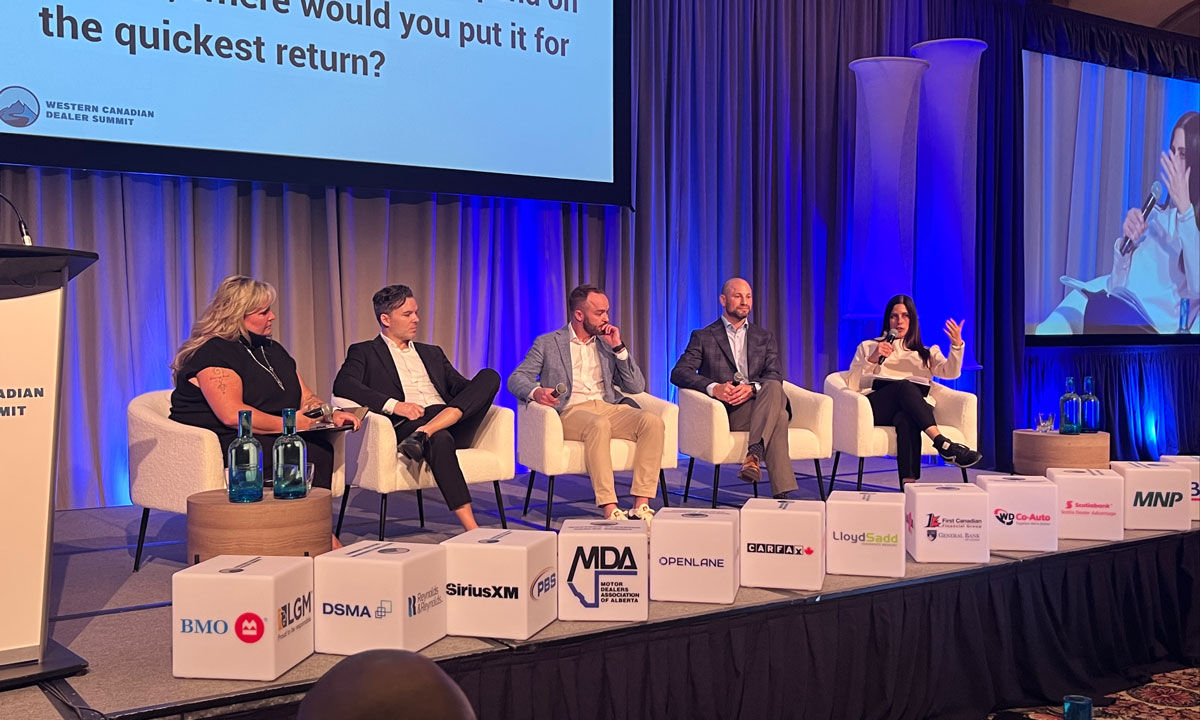At the Western Canadian Dealer Summit in Lake Louise, four dealers detailed how they are adapting to rising workplace expectations, rapid AI adoption, uneven EV demand and shifting OEM relationships.
Dealer moderator Ann Marie Clark, Executive Vice Chair of the New Car Dealers Association of B.C., (NCDA) led a candid discussion with Andrea Ulmer of UF3 Auto Group, Jamie Kaban of Kelowna Toyota, David Hennessey of Harris Auto Group and Kevin Sharfe of Sherwood Chevrolet on what’s working, what’s breaking, and where dealers need to focus next.
The dealers agreed that the post-pandemic workforce requires a different leadership lens. Andrea Ulmer, CEO of UF3 Auto Group, said her teams perform at a high level because expectations are clear and consistently reinforced.
“You just have to define what winning looks like for every position,” she said. She said her stores review labour sales, hours per repair order and CSI performance in morning huddles so staff “know if they’re winning or they’re not.”
But Ulmer said culture matters even more. She described longstanding rules that protect family time, whether for school concerts or medical emergencies. Years ago she sent a sales manager home for a month, fully paid, to be with a child who needed heart surgery. When Ulmer later faced cancer, her team stepped in without question. “It has to be part of the DNA,” she said, noting the store that most embodies that culture is now her group’s top performer.
David Hennessey, Vice-President of Fixed Operations at Harris Auto Group, said supporting different schedules has become essential. Some staff work five eight-hour days, others prefer four tens or three twelves. “As long as it’s still convenient for our customers, we should be as flexible as possible,” he said. Harris Auto Group added a technician recognition program this year to ensure techs receive the same acknowledgment as frontline staff.
Jamie Kaban, General Manager of Kelowna Toyota, said work-life balance improvements were achieved locally since every store in the region closes Sundays and statutory holidays, and none stay open past 6 p.m. “Cutting back those hours had no effect on our business whatsoever,” he said, adding that it eliminated split shifts and simplified scheduling.
Kevin Sharfe, Dealer Principal of Sherwood Chevrolet, said his approach is case-by-case. “We’ll accommodate each person however it’s appropriate, and if it’s not right, we won’t,” he said. With more than half of staff employed for a decade or longer, he believes individualized flexibility is working. He also shared leadership advice from his father: “When you walk into a room, you carry their very biggest big stick. Just be aware of how you handle it.”
AI adoption grows
Across the panel, AI was described as both a powerful tool and a source of new operational risk.
Ulmer said she starts every AI conversation with a simple filter: what problem does it solve. She said her Nissan, Stellantis and Toyota stores use AI for first-contact sales leads and for handling service booking when advisors miss calls. “We’ve had really good experiences… good contact rates on the fourth or fifth response,” she said, calling the consistency a major advantage. She expects AI-assisted marketing analytics to provide clearer ROI without requiring specialist expertise.
Sharfe said he once saw AI as “a big scary monster,” but now views immediate-response AI in BDC as the simplest and most effective starting point. It frees staff to focus on higher-value work. But training matters. His team monitors whether the bot or a person set an appointment so issues can be corrected quickly.
Kaban said AI’s biggest impact is on staff productivity. “One of our most important jobs is to make the lives of our staff easier,” he said. Improved data mining now identifies equity and service opportunities more accurately, which means advisors spend less time prospecting and more time with customers.
Hennessey cautioned that none of these tools work with poor data. “If you’re using it with bad data, it’s not going to do anything for you,” he said. His group uses AI for diagnostics and warranty story-writing by feeding customer concerns and trouble codes into a large-language-model tool to produce clear, compliant narratives.
When asked who handles AI errors, the panel was unanimous: managers. “You’re responsible,” said Hennessey. Daily oversight is required, especially for agentic systems that “learn” over time. Kaban noted that insufficient training leads to inaccurate messages and nonsensical customer outreach.
Ulmer shared two cautionary examples. A service-reach-out tool wasn’t connected to the scheduler, so customers who had already booked appointments kept receiving outreach. And since AI began picking up inbound calls, some service advisors now allow the system to answer even when they are free. “You just have to watch it… be on top of it all the time,” she said.
OEM expectations are shifting
On the question of which metric matters most to OEMs, dealers offered different answers based on their brands and experience.
Hennessey pointed to customer experience and service retention, calling retention “the number one pulse check on the health of your operation.”
Kaban said Toyota dealers have one clear priority: CSI. Toyota’s President’s report card ranks stores nationally and is the key data point when the OEM considers dealer expansion.
Sharfe cited sales market share but added that OEMs are increasingly evaluating financial stability and succession strength. With many ownership transitions underway, manufacturers want reassurance that stores and families can weather disruption.
Ulmer said dealer profitability and employee retention are emerging counter-metrics she is raising with OEMs. Retention in her Toyota stores is higher than in her Nissan and Stellantis locations, and she believes OEMs must take responsibility for the operational challenges their decisions create.
On the broader question of dealer–OEM relationships, Sharfe said interactions feel more personal today, but he isn’t certain dealers carry the same influence they once had. Hennessey said relationships differ significantly by brand, with some OEMs maintaining strong, collaborative ties and others keeping field reps at distance. Kaban added that some reps have limited authority, forcing dealers to escalate routine issues to zone or executive levels.
Ulmer noted that OEMs backing away from agency-style experiments suggests they may again recognize the value of the franchise model.
The regional differences in EV adoption were stark.
Kaban described the situation in Kelowna as “tough.” Despite low local demand, he was recently allocated 35 new vehicles, 32 of which were electrified. “We’re pretty much giving them away,” he said. He urged dealers in non-mandated provinces to stay close to their associations and elected officials, calling mandates “a really big deal” for dealers in smaller or rural markets.
Sharfe said Saskatchewan customers remain selective. EVs are high-quality products, but “very expensive,” and legislated uptake “messes everything up.” He said the current environment feels more stable than last year, but demand remains modest.
Ulmer reported strong hybrid and electrified demand in her Toyota stores but said Nissan trails, and Stellantis had previously tied gas-vehicle inventory to EV acceptance. “Our solution is we’re just not going to order them,” she said.
Preparing technicians for EV work
Hennessey’s group now pays technicians straight time plus an additional hourly premium on EV jobs to reflect the complexity and training required. “The response has been great,” he said. Techs who once tried to avoid EV work now pursue it.
Kaban said Kelowna Toyota uses a straight-time system and adopted a high-tech rate for EV service several years ago. “We haven’t had a single complaint,” he said.














